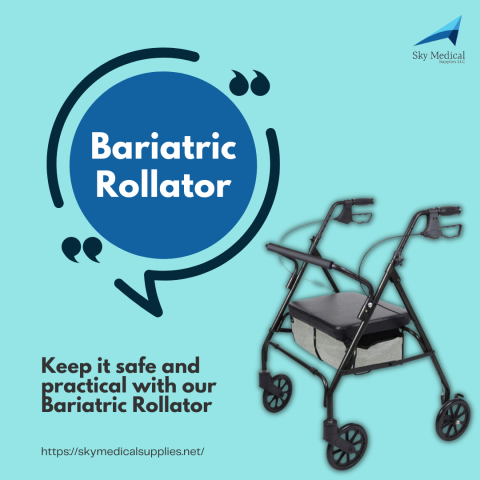
It is challenging to deal with mobility problems. It can be frustrating to be unable to move about freely on your own, let alone leave the house. With the help of a rollator walker, people who need mobility aids can maintain independence. A rollator walker like Rollator Walker foldable vive health can be a lifesaver for those with mobility issues.
What is a Rollator, and who does it for?
Mobility devices, known as rollators or rolling walkers, have three or four legs and a broad base for stability on both sides. The wheels at the bottom of each leg make them easy to maneuver, similar to standard adult walkers. There are even some with a seat so you can rest comfortably.
In addition to providing stability and balance, rollators are suitable for people who:
Balance or stability issues that are moderate to mild
Walking quickly makes you tired, so you need a place to rest between walks
In recovery from surgery and require both sides of their body to be supported
People who are unable to walk on their own because of old age, bone loss, or weak bones are at risk of falling
How to choose a Rollator walker
Buying a rollator walker requires consideration of the following tips:
Decide whether you want three legs or four legs
As mentioned earlier, a rollator can be either a three-wheel or a four-wheel model. Both options have their advantages and disadvantages. Rollators with three wheels are narrower, so they can fit through smaller passageways and make tight turns, which makes them more popular indoors.
It is also lightweight and portable. These rollators, however, are less stable because they have odd numbers of wheels. There are also some without seats.
Most people prefer rollators with four wheels. The four-wheeled version is more stable and can accommodate more weights and heights despite being heavier and broader than the three-wheeled version. You can rest on the convenient seat when you get tired walking.
Think of the wheel size
It would be helpful to consider the wheels' diameter after deciding the number of wheels you want. Six to ten inches is the average diameter of rollator wheels.
It would be best to consider where you would primarily use your rollator when determining the wheel size you need. This rollator can handle uneven and bumpy outdoor terrain better than a rollator with smaller wheels (eight inches and less).
Rollators with smaller wheels (six to seven inches) are best if you plan to use them mostly indoors. Walking through narrow hallways would be easier with the smaller size.
Ensure proper fitting and capacity
To improve your health and comfort, you need to find a rollator that fits your weight, height and build. Please ensure the one you're considering will fit your body well before purchasing it. Here are some things you should consider:
Seat size
You can rest on a seat on most rollators. There are 13- to 18-inch standard seat widths. There should, however, be several inches of extra width inside the rollator. Measure your backside's width while sitting on a flat surface.
Depending on how comfortable you want your seat to be, add a few inches to the measurement you get.
Seat height
Your feet should not dangle from your seat or floor to achieve a reasonable seat height. The length of your knee is measured from the crease in the back of your knee to the ground while you are standing.
This should indicate a rollator's seat height. The seat height of some rollators can be adjusted according to your preference.
Handle height
When using a rollator, it is essential to maintain proper posture. Because you don't want the handle height to be too low, you don't want to slouch as you walk.
Ask someone to help you determine the proper handle height. Your elbows should be slightly bent while you stand up. Make sure that someone measures how far your wrist is from the ground.
A rollator's handle height is usually suitable for people of average height. Finding ones designed specifically for taller or shorter people is also possible. This rollator, for example, has an adjustable handle height that can be adjusted in a wide range.
Capacity for weight
Along with ensuring a proper fit, you should also consider whether the rollator can support your weight. Standard rollators can support around 250 to 350 pounds. Rollators that can accommodate up to 500 pounds are durable and heavy-duty. To provide reliable support, models with a higher weight capacity tend to be heavier.
Taking into account weight and portability
It is essential to consider the overall weight of a rollator if you need to transport your mobility aid occasionally.
Traveling with a lightweight rollator is convenient. Aluminum is usually used for the frame, making the device portable. For hassle-free storage, foldable rollators can easily collapse when not in use.
You shouldn't use a rollator that weighs more than 25 pounds if you live alone or travel alone.
The inclusion of accessories is essential
The cost of a rollator can be high. Ensure the option includes accessories and the usual specs to make the most of your investment. There are usually a few grocery bags, a storage pouch, or a basket for personal belongings attached to most rollators.
Freebies and separate purchases may be available for other accessories. These items include seat covers, cups, cane holders, and portable flashlights.
Bottom line
The ability to get around independently plays a significant role in independence. A vive upright rollator walker can significantly reduce the risk of falling, regardless of whether you struggle with balance or leg strength problems. It'll also allow you to maintain mobility and accomplish daily activities independently.